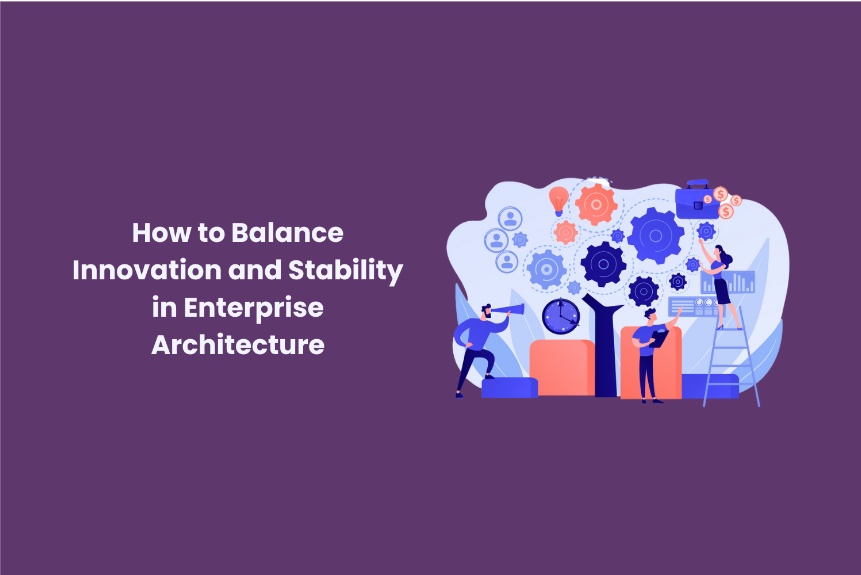Like conducting a symphony, business architecture requires striking a balance between experimentation and stability. Organisations, like orchestras, need a conductor to lead them through the tumultuous waters of modern-day business, and the ArchiMate Framework is stepping up to the plate to play that role. In this blog, we'll explore how enterprise architecture can be a fertile ground for both innovation and stability.
Table of Contents
- Supporting Harmony with the ArchiMate Framework
- A Necessity for Innovation
- Identifying Opportunities for Innovation
- Ensuring Stability
- Maintaining Stability in Operations
- Integration of Legacy Systems
- Using a Holistic Approach
- Building a Culture of Cooperation
- Agile Architectural Practices
- Continuous Monitoring and Adaptation
- Case Study: Striking the Balance
- Adaptive Architectural Strategies
- Conclusion
Supporting Harmony with the ArchiMate Framework
Getting to know the ArchiMate Framework is the first step before delving into the nuances of balancing innovation and stability. The Open Group sponsored the creation of this framework to standardise communication amongst enterprise architects. It offers a standardised language and notation system for the purpose of documenting, analysing, and visualising business structures. The ArchiMate Framework promotes making innovation an inherent part of business architecture.
A Necessity for Innovation
Innovation is no longer an added benefit in today's highly competitive corporate world; it's a need. It drives businesses ahead by helping them embrace change, seize opportunities, and achieve a competitive advantage. Companies nowadays need to be ready to welcome innovation within the sphere of their enterprise architecture if they want to remain relevant and nimble.
Identifying Opportunities for Innovation
Organisations are urged to seize innovation possibilities as they arise with the help of the ArchiMate Framework. Possible solutions include making use of new technology, switching to an agile approach, or inventing new ways to serve customers. Organisations can now better coordinate these developments with their overall architectural objectives thanks to ArchiMate Framework's standardised methodology.
Ensuring Stability
While new ideas are what drive development, stability is what keeps things running well for any business. For the sake of company continuity and stakeholder trust, it is crucial to keep essential systems running smoothly.
Maintaining Stability in Operations
The job of an enterprise architect is to design a solid architectural foundation that can survive disturbances from any source, whether they are internal hiccups or foreign attacks. The ArchiMate Framework acts as a map, pointing you to where you need to put in place redundancy, failover methods, and disaster recovery strategies.
Integration of Legacy Systems
Legacy systems are the driving force behind many businesses and are thus difficult or impossible to replace. Despite their inflexibility compared to newer technology, these systems are essential for safety. Using the ArchiMate Framework, architects are provided with methods for effectively incorporating existing systems into their design.
Using a Holistic Approach
Enterprise architecture that takes a comprehensive view is the key to achieving a healthy balance between innovation and stability. Business processes, data, technology, and personnel are all included in this integrated strategy.
Building a Culture of Cooperation
Enterprise architects' primary responsibility is to encourage innovation and stability through fostering cooperation between IT and business stakeholders. Through the ArchiMate Framework's facilitation of open dialogue and shared understanding, architects may serve as a link between forward-thinking business executives and cautious IT specialists.
Agile Architectural Practices
Enterprise architecture may benefit from the use of agile methods, which are more often associated with software development. Agile approaches allow architects to respond rapidly to changing business demands without compromising the design.
Continuous Monitoring and Adaptation
The fast-paced nature of business requires constant vigilance and the readiness to make adjustments. Through the use of the ArchiMate Framework, architects are provided with the data they need to monitor KPIs and adapt their designs to meet the ever-changing demands of the company.
Case Study: Striking the Balance
Let's take a look at a real-world example to see how the ArchiMate Framework may help you strike the right balance between innovation and stability.
As a market leader, XYZ Corporation in the financial industry felt increasing pressure to provide new products and services which would meet customers' changing needs. At the same time, they needed to protect their fundamental financial infrastructures.
Enterprise architects at XYZ used the ArchiMate Framework to conduct an in-depth evaluation of the company's architecture. They saw a chance to improve their backend systems' dependability and security while also introducing cutting-edge digital banking alternatives.
Adaptive Architectural Strategies
Let's go further into the concept of adaptable architectural techniques in our quest to perfect the balance between innovation and stability in corporate design. These plans provide the backbone of how businesses adapt to new environments and shifting priorities.
The ArchiMate Framework promotes structures that are adaptable to new information and circumstances by promoting adaptive architectural techniques. This method helps us achieve our ultimate aim of harmony between innovation and stability by making sure our architectural choices are flexible, robust, and up-to-date.
By using a proactive approach, architects may better adapt to changing conditions by designing with adaptability in mind. This way of thinking, when paired with the methodical ArchiMate Framework, gives businesses a fighting chance in today's uncertain and volatile environment.
Conclusion
Mastering the skill of combining innovation and stability in enterprise architecture is a worthy goal. Organisations can confidently dance this complex tango with the help of the ArchiMate Framework. The only way for businesses to maintain growth and competitiveness in today's volatile market is to embrace innovation while also strengthening the reliability of their most important systems.


No comments yet